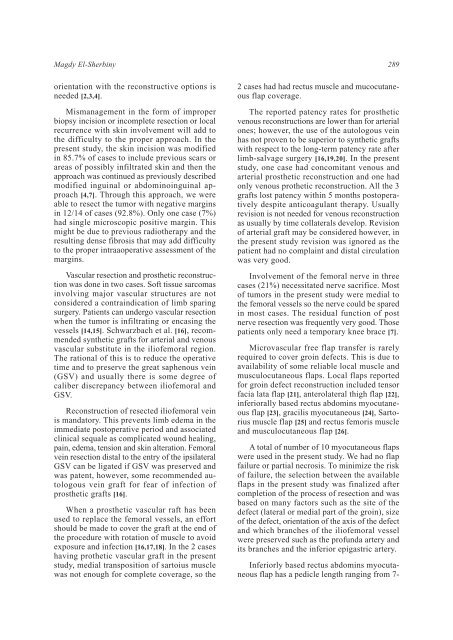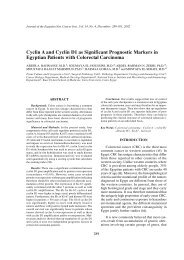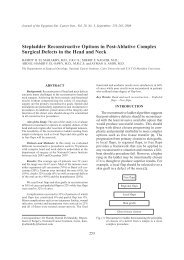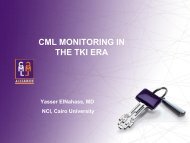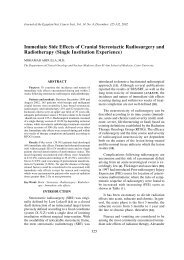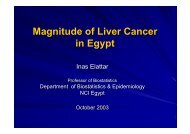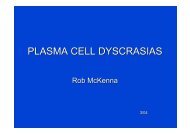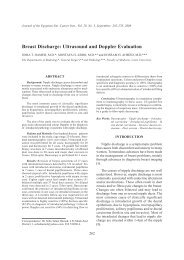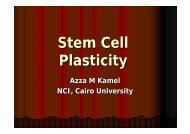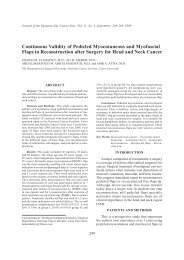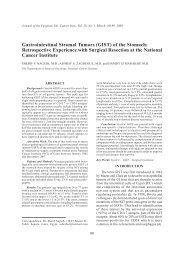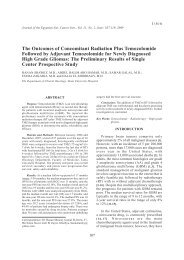Limb Sparing Surgical Resection of Groin Sarcoma. Surgical ... - NCI
Limb Sparing Surgical Resection of Groin Sarcoma. Surgical ... - NCI
Limb Sparing Surgical Resection of Groin Sarcoma. Surgical ... - NCI
You also want an ePaper? Increase the reach of your titles
YUMPU automatically turns print PDFs into web optimized ePapers that Google loves.
Magdy El-Sherbiny 289orientation with the reconstructive options isneeded [2,3,4].Mismanagement in the form <strong>of</strong> improperbiopsy incision or incomplete resection or localrecurrence with skin involvement will add tothe difficulty to the proper approach. In thepresent study, the skin incision was modifiedin 85.7% <strong>of</strong> cases to include previous scars orareas <strong>of</strong> possibly infiltrated skin and then theapproach was continued as previously describedmodified inguinal or abdominoinguinal approach[4,7]. Through this approach, we wereable to resect the tumor with negative marginsin 12/14 <strong>of</strong> cases (92.8%). Only one case (7%)had single microscopic positive margin. Thismight be due to previous radiotherapy and theresulting dense fibrosis that may add difficultyto the proper intraaoperative assessment <strong>of</strong> themargins.Vascular resection and prosthetic reconstructionwas done in two cases. S<strong>of</strong>t tissue sarcomasinvolving major vascular structures are notconsidered a contraindication <strong>of</strong> limb sparingsurgery. Patients can undergo vascular resectionwhen the tumor is infiltrating or encasing thevessels [14,15]. Schwarzbach et al. [16], recommendedsynthetic grafts for arterial and venousvascular substitute in the ili<strong>of</strong>emoral region.The rational <strong>of</strong> this is to reduce the operativetime and to preserve the great saphenous vein(GSV) and usually there is some degree <strong>of</strong>caliber discrepancy between ili<strong>of</strong>emoral andGSV.Reconstruction <strong>of</strong> resected ili<strong>of</strong>emoral veinis mandatory. This prevents limb edema in theimmediate postoperative period and associatedclinical sequale as complicated wound healing,pain, edema, tension and skin alteration. Femoralvein resection distal to the entry <strong>of</strong> the ipsilateralGSV can be ligated if GSV was preserved andwas patent, however, some recommended autologousvein graft for fear <strong>of</strong> infection <strong>of</strong>prosthetic grafts [16].When a prosthetic vascular raft has beenused to replace the femoral vessels, an effortshould be made to cover the graft at the end <strong>of</strong>the procedure with rotation <strong>of</strong> muscle to avoidexposure and infection [16,17,18]. In the 2 caseshaving prothetic vascular graft in the presentstudy, medial transposition <strong>of</strong> sartoius musclewas not enough for complete coverage, so the2 cases had had rectus muscle and mucocutaneousflap coverage.The reported patency rates for prostheticvenous reconstructions are lower than for arterialones; however, the use <strong>of</strong> the autologous veinhas not proven to be superior to synthetic graftswith respect to the long-term patency rate afterlimb-salvage surgery [16,19,20]. In the presentstudy, one case had concomitant venous andarterial prosthetic reconstruction and one hadonly venous prothetic reconstruction. All the 3grafts lost patency within 5 months postoperativelydespite anticoagulant therapy. Usuallyrevision is not needed for venous reconstructionas usually by time collaterals develop. Revision<strong>of</strong> arterial graft may be considered however, inthe present study revision was ignored as thepatient had no complaint and distal circulationwas very good.Involvement <strong>of</strong> the femoral nerve in threecases (21%) necessitated nerve sacrifice. Most<strong>of</strong> tumors in the present study were medial tothe femoral vessels so the nerve could be sparedin most cases. The residual function <strong>of</strong> postnerve resection was frequently very good. Thosepatients only need a temporary knee brace [7].Microvascular free flap transfer is rarelyrequired to cover groin defects. This is due toavailability <strong>of</strong> some reliable local muscle andmusculocutaneous flaps. Local flaps reportedfor groin defect reconstruction included tensorfacia lata flap [21], anterolateral thigh flap [22],inferiorally based rectus abdomins myocutaneousflap [23], gracilis myocutaneous [24], Sartoriusmuscle flap [25] and rectus femoris muscleand musculocutaneous flap [26].A total <strong>of</strong> number <strong>of</strong> 10 myocutaneous flapswere used in the present study. We had no flapfailure or partial necrosis. To minimize the risk<strong>of</strong> failure, the selection between the availableflaps in the present study was finalized aftercompletion <strong>of</strong> the process <strong>of</strong> resection and wasbased on many factors such as the site <strong>of</strong> thedefect (lateral or medial part <strong>of</strong> the groin), size<strong>of</strong> the defect, orientation <strong>of</strong> the axis <strong>of</strong> the defectand which branches <strong>of</strong> the ili<strong>of</strong>emoral vesselwere preserved such as the pr<strong>of</strong>unda artery andits branches and the inferior epigastric artery.Inferiorly based rectus abdomins myocutaneousflap has a pedicle length ranging from 7-


